*IN MEMORIAM*
Charlie Wadhams passed away May 19, 2020 at the age 93. Click here to read his obituary.
Use controls above or click here to open this Hometown Heroes podcast in a new window
88-year-old Charlie Wadhams of Fresno, CA appears on episode #380 of Hometown Heroes, debuting August 15, 2015. Growing up in Brockport, NY, as the son of a World War I veteran, Wadhams enlisted in the Navy at the age of 17 in 1944.
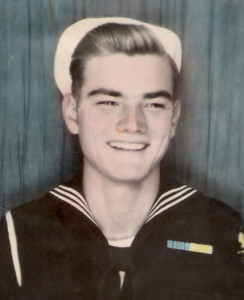
You’ll hear Charlie discuss familiar themes like kamikazes, typhoons, and the destruction and devastation of war, but you’ll also hear some emotional moments that speak to the power of family. Before he’s done you’ll learn about a secret he had to keep during the Korean War that remains a largely unknown piece of world history.
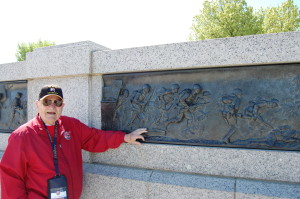
You’ll hear Charlie reflect on his childhood in upstate New York as the youngest of three children, and find out why his stated career goal when he entered the Navy was to become a “refrigeration engineer.” How did he go to college for eight years before entering high school? Why did his father, who had served in the Army during World War I, encourage Charlie to choose the Navy? This youthful octogenarian will answer those questions, describe the amphibious training he received, and help us understand what it was like to operate LCVPs off of the attack transport U.S.S. Brookings (APA-140) in the Pacific in 1945. When not piloting a landing craft, Wadhams’ duties aboard ship included manning a 20-millimeter anti-aircraft gun.
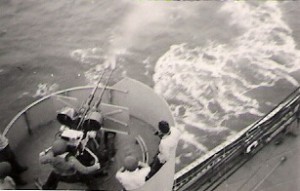
There’s only one question anyone using one of those guns to fire at enemy airplanes would ask, according to Wadhams.
“Why can’t this thing shoot faster?”
He would observe the aftermath of high-casualty battles like Iwo Jima and Saipan, and make a few LCVP trips to the northern shore of Okinawa while fighting continued to rage on the south end of the island, but perhaps the most harrowing moments he experienced came in surviving the crashing waves of five different typhoons aboard his APA. “You look and see that the two masts are going in opposite directions,” Charlie recalls. “You say, ‘It could tear this thing apart!’ You were watching every wave.”
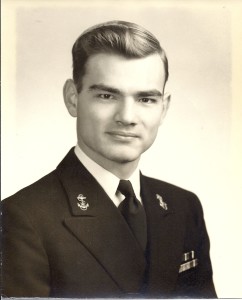
Listen to the interview for Charlie’s memories of learning atomic bombs had been dropped on Hiroshima and Nagasaki, and to hear what he was doing to prepare for the planned invasion of Japan when news came that the emperor had decided to surrender. He shares what he saw, two months later, when he stood on a hillside overlooking Nagasaki, and he explains why he feels President Truman made the correct choice in deploying atomic weapons. You’re familiar with the difficult decisions Truman had to make in 1945, but Wadhams reveals another dilemma our 33rd president faced during the Korean War. It was a top secret situation then, and remains largely unknown today.
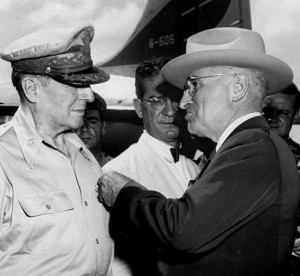
Charlie had used the G.I. Bill to go to college before the Navy recalled him for the Korean War. His four years at the University of Rochester brought him a degree and a bride. Charlie and Anne married shortly before he reported to Pearl Harbor as a top secret watch officer in December, 1950. His immediate supervisor was a lieutenant named Dick Geller who would become his closest friend and confidant. They were all working under Rear Admiral Edwin Layton, who was a bit of a legendary figure for helping to break the Japanese code, leading to the pivotal Allied victory in the Battle of Midway. Much of the work they did in codes, ciphers, and communications remains off limits for Wadhams to discuss, even more than six decades later. As you’ll hear, he is willing to discuss his interactions with Harry Truman when the president visited their Hawaii headquarters, and also about another history-altering decision made by Truman, which Charlie was privy to because of his duty as a cryptanalyst. For a broad view of nuclear possibilities during the Korean War, read this article from the Smithsonian’s Air & Space magazine. It is noted there that President Truman ordered nine fully functional nuclear bombs to Okinawa in April, 1951, but what the article doesn’t tell you is how close at least one of those bombs came to landing on Chinese forces. “We started a project which was very highly classified,” Wadhams remembers. “Projecting the weather patterns, picking targets, identifying where their weapons were.” The process went on for two weeks, culminating with a nuclear-armed American bomber in the air over North Korea when the operation was called off.
“Negative, negative, negative,”
is how Charlie remembers the end of an urgent, “flash” message, followed by a dubious postscript. “This is a drill.” Listen to the interview to find out why Charlie and the other intelligence workers did not believe it was a drill, and why he’s convinced that the decision not to drop the bomb was the right call. “I’m inclined to believe that they couldn’t find a concentration of Chinese troops that was big enough to make it worth it,” Wadhams explains. “For what it would do to the world situation.” You’ll hear Charlie relate how he and Dick Geller supported each other while processing the tension and gravity of the sensitive info they dealt with on a daily basis, and the possibility of a nuclear detonation altering the global landscape. “It was a heavy load,” he says. “We knew what we were doing.”
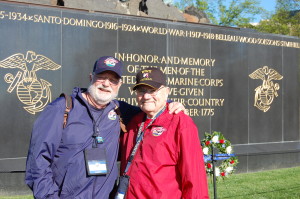
As eye opening as Charlie’s recollections of that piece of unknown Korean War history might be, perhaps the most powerful portions of his interview come when he hear about a pair of embraces, 70 years apart. The first came when he returned home from World War II, seeing his father for the first time in two years when he stepped off the bus in Brockport. “Thank God you made it,” he remembers his father saying after a big hug. “Like many papas at that time,” Charlie says. “We were on a handshaking basis when I was five years old. After that day, we never saw each other without a hug.” Listen at the 34-minute mark of the podcast linked above to hear the emotion in Charlie’s voice as he tells that story, and at the 54-minute mark to hear another hugging account from Dr. Rick Geller. Rick is the son of Charlie’s best Navy buddy, but also, since marrying Charlie’s daughter Jean in 1983, his son-in-law. He accompanied Charlie to Washington, D.C. with Central Valley Honor Flight, and you’ll hear him describe a moment they shared at the National World War II Memorial.
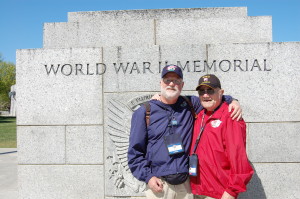
“We brought three stones from California to leave at the World War II Memorial,” Rick explains, noting that two were for Charlie’s brothers-in-law who had served in Europe. “We left a stone in the Pacific Theater for my father,” Geller continues.
“And then the two of us – two grown men – fell into each other’s arms and just sobbed, remembering my dad and what he meant to us, and also what we meant to each other.”
One other encounter from Wadhams’ Honor Flight experience might catch your ear as you listen. While touring the Korean War Memorial, the group was greeted by high school students who thanked the veterans for their service. “Are you studying this?,” he asked the young people. “Remember what happened and darned well never let it happen again, that’s your job as a citizen.” Charlie cautioned them that history will repeat itself if current generations fail to learn from those who have gone before. Thanks for keeping history alive, Charlie, and for sharing a piece of Korean War history that most of us would have never imagined.
—Paul Loeffler
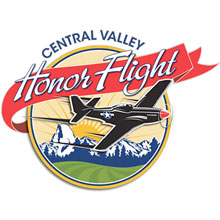

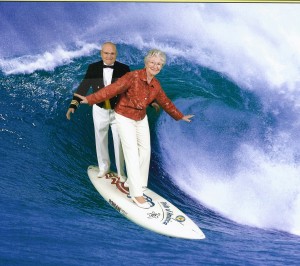
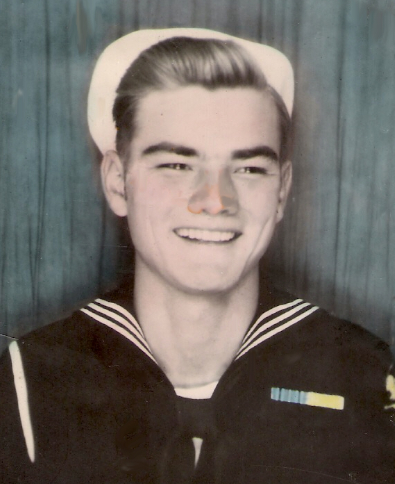
Leave a Reply